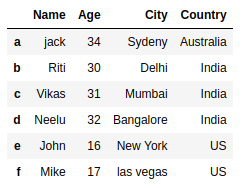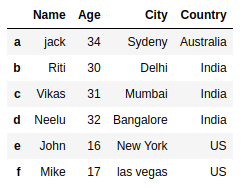Tag: column
Python Pandas : Replace or change Column & Row index names in DataFrame
In this article we will discuss how to change column names or Row Index names in DataFrame object. First of all, create a dataframe object of students records i.e. Advertisements students = [ (‘jack’, 34, ‘Sydeny’) , (‘Riti’, 30, ‘Delhi’ ) , (‘Aadi’, 16, ‘New York’) ] # Create a DataFrame object dfObj = pd.DataFrame(students, …
Python Pandas : Replace or change Column & Row index names in DataFrameRead More
Python Pandas : How to get column and row names in DataFrame
In this article we discuss how to get a list of column and row names of a DataFrame object in python pandas. First of all, create a DataFrame object of students records i.e. Advertisements # List of tuples students = [ (‘jack’, 34, ‘Sydeny’ , ‘Australia’) , (‘Riti’, 30, ‘Delhi’ , ‘India’ ) , (‘Vikas’, …
Python Pandas : How to get column and row names in DataFrameRead More
Python Pandas : How to Drop rows in DataFrame by conditions on column values
In this article we will discuss how to delete rows based in DataFrame by checking multiple conditions on column values. DataFrame provides a member function drop() i.e. Advertisements DataFrame.drop(labels=None, axis=0, index=None, columns=None, level=None, inplace=False, errors=’raise’) It accepts a single or list of label names and deletes the corresponding rows or columns (based on value of axis …
Python Pandas : How to Drop rows in DataFrame by conditions on column valuesRead More
Pandas: Add Column to Dataframe
In this article, we will discuss different ways to how to add a new column to dataframe in pandas i.e. using operator [] or assign() function or insert() function or using a dictionary. We will also discuss adding a new column by populating values from a list, using the same value in all indices, or …
Python Pandas : Count NaN or missing values in DataFrame ( also row & column wise)
In this article we will discuss how to find NaN or missing values in a Dataframe. Manytimes we create a DataFrame from an exsisting dataset and it might contain some missing values in any column or row. For every missing value Pandas add NaN at it’s place. Advertisements Let’s create a dataframe with missing values i.e. …
Python Pandas : Count NaN or missing values in DataFrame ( also row & column wise)Read More
Pandas: Apply Function to Column
In this article, we will discuss different ways to apply a given function to selected columns or rows of a Pandas DataFrame. Table Of Contents Apply a function to a single column in Dataframe. Apply a function to a single row in Dataframe. Apply a function to a certain columns in Dataframe. Apply a function …
Pandas : Sort a DataFrame based on column names or row index labels using Dataframe.sort_index()
In this article we will discuss how to sort the contents of dataframe based on column names or row index labels using Dataframe.sort_index(). Dataframe.sort_index() In Python’s Pandas Library, Dataframe class provides a member function sort_index() to sort a DataFrame based on label names along the axis i.e. Advertisements DataFrame.sort_index(axis=0, level=None, ascending=True, inplace=False, kind=’quicksort’, na_position=’last’, sort_remaining=True, …
Sorting 2D Numpy Array by column or row in Python
In this article we will discuss how to sort a 2D Numpy array by single or multiple rows or columns. Sorting 2D Numpy Array by a column First of all import numpy module i.e. Advertisements import numpy as np Now suppose we have a 2D Numpy array i.e. # Create a 2D Numpy array list …
How to convert Dataframe column type from string to date time
In this article we will discuss how to convert data type of a dataframe column from string to datetime. The data can be in custom string formats or embedded in big text. Also, how to handle error while converting the data type. Python’s Pandas module provides a function to convert a given argument to datetime …
How to convert Dataframe column type from string to date timeRead More
Pandas : Convert Dataframe column into an index using set_index() in Python
In this article, we will discuss that in pandas, how to convert an existing column of a Dataframe to an index, and also various scenarios associated with it. Pandas Dataframe class provides a function set_index (). Let’s first have a look at that, Advertisements DataFrame.set_index() DataFrame.set_index(self, keys, drop=True, append=False, inplace=False, verify_integrity=False) It accepts column names in the keys argument and …
Pandas : Convert Dataframe column into an index using set_index() in PythonRead More

